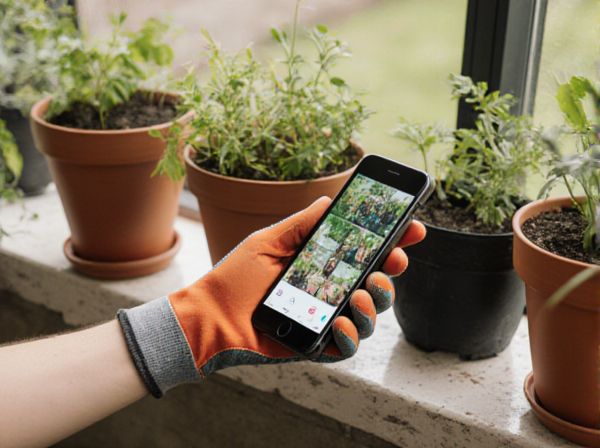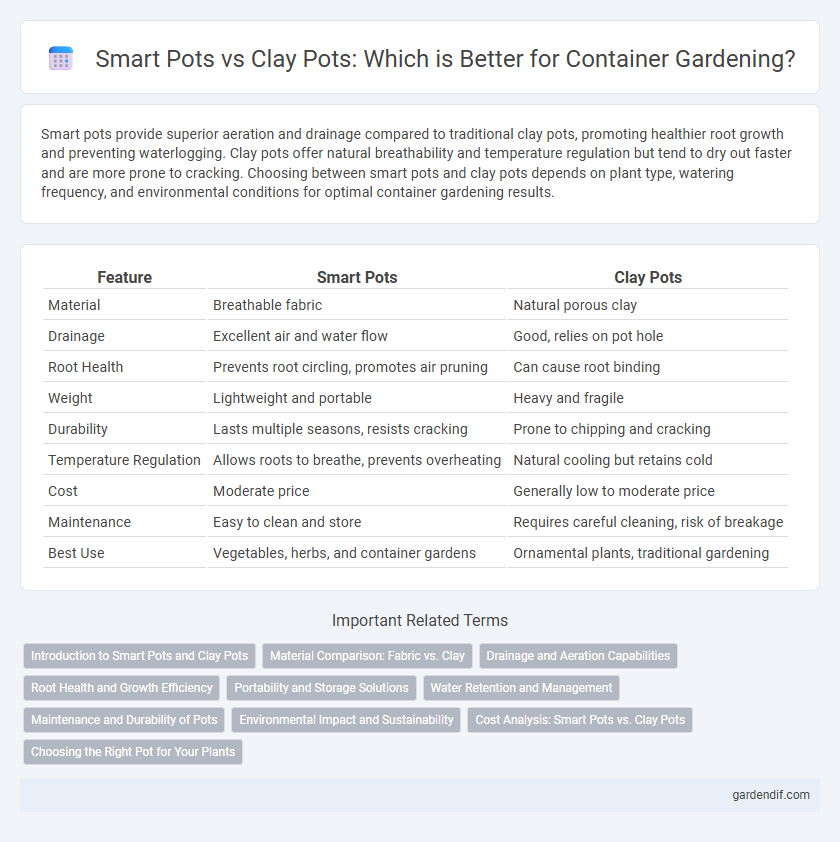
Smart pots vs clay pots Illustration
Smart pots provide superior aeration and drainage compared to traditional clay pots, promoting healthier root growth and preventing waterlogging. Clay pots offer natural breathability and temperature regulation but tend to dry out faster and are more prone to cracking. Choosing between smart pots and clay pots depends on plant type, watering frequency, and environmental conditions for optimal container gardening results.
Table of Comparison
| Feature | Smart Pots | Clay Pots |
|---|---|---|
| Material | Breathable fabric | Natural porous clay |
| Drainage | Excellent air and water flow | Good, relies on pot hole |
| Root Health | Prevents root circling, promotes air pruning | Can cause root binding |
| Weight | Lightweight and portable | Heavy and fragile |
| Durability | Lasts multiple seasons, resists cracking | Prone to chipping and cracking |
| Temperature Regulation | Allows roots to breathe, prevents overheating | Natural cooling but retains cold |
| Cost | Moderate price | Generally low to moderate price |
| Maintenance | Easy to clean and store | Requires careful cleaning, risk of breakage |
| Best Use | Vegetables, herbs, and container gardens | Ornamental plants, traditional gardening |
Introduction to Smart Pots and Clay Pots
Smart Pots, made from breathable fabric, enhance root growth by air pruning, preventing root circling and improving aeration and drainage. Clay pots, traditional terracotta containers, offer natural porous walls that regulate moisture through evaporation but may cause faster drying. Both options suit container gardening, with Smart Pots favoring active root development and clay pots providing classic moisture control.
Material Comparison: Fabric vs. Clay
Smart pots are made from breathable fabric that allows superior aeration and drainage, preventing root circling and promoting healthy root growth. Clay pots, crafted from porous terracotta, naturally regulate moisture but can dry out quickly and are prone to cracking in extreme weather. The fabric material's flexibility and lightweight nature offer greater durability and ease of handling compared to the rigid and fragile clay alternative.
Drainage and Aeration Capabilities
Smart pots feature breathable fabric walls that enhance drainage and promote superior aeration by allowing air to circulate freely around the roots, preventing waterlogging and root rot. Clay pots, while porous and capable of some aeration, often retain excess moisture due to slower evaporation, which can lead to poor drainage. The superior aeration of smart pots supports healthier root development and more efficient moisture regulation compared to traditional clay containers.
Root Health and Growth Efficiency
Smart pots enhance root health by providing superior aeration and drainage compared to traditional clay pots, preventing root rot and promoting oxygen flow. Their breathable fabric construction encourages air pruning, which stimulates a more fibrous and efficient root system, leading to faster nutrient uptake and improved overall growth. Clay pots retain moisture longer but may restrict root expansion and reduce oxygen availability, potentially limiting plant development and growth efficiency.
Portability and Storage Solutions
Smart pots offer superior portability and storage solutions compared to traditional clay pots due to their lightweight, foldable design that allows easy transport and compact storage. Clay pots are heavy and fragile, making them cumbersome to move and requiring more space for safe storage. Innovative materials in smart pots ensure durability and space efficiency, ideal for gardeners with limited storage or those who frequently relocate plants.
Water Retention and Management
Smart pots offer superior water retention due to their breathable fabric design, which allows excess moisture to evaporate while maintaining consistent soil hydration. Clay pots, being porous, tend to lose water quickly through evaporation, requiring more frequent watering to maintain optimal moisture levels. Efficient water management in smart pots reduces the risk of overwatering and root rot, promoting healthier plant growth.
Maintenance and Durability of Pots
Smart pots offer superior maintenance ease due to their breathable, lightweight fabric that resists cracking and fading, unlike traditional clay pots which can be porous and prone to chipping over time. Clay pots require regular sealing and careful handling to prevent breakage and water absorption, which can lead to faster degradation. The durable material of smart pots ensures long-term use with minimal effort, making them ideal for sustainable container gardening.
Environmental Impact and Sustainability
Smart pots are made from breathable fabric materials that promote root aeration and reduce water runoff, significantly decreasing the need for frequent watering and lowering environmental impact compared to traditional clay pots. Clay pots, while biodegradable and natural, require energy-intensive firing processes that increase carbon emissions and limit their sustainability. Choosing smart pots supports water conservation and reduces soil disruption, making them a more eco-friendly option for sustainable gardening practices.
Cost Analysis: Smart Pots vs. Clay Pots
Smart pots generally cost less than traditional clay pots, with prices typically ranging from $10 to $30 depending on size and brand, while clay pots often start around $15 and can exceed $50. The lightweight and durable nature of smart pots reduces shipping and replacement costs compared to fragile clay pots that are prone to cracking and chipping. Over time, smart pots offer better value due to their reusability and lower maintenance expenses, making them a cost-effective option for gardeners.
Choosing the Right Pot for Your Plants
Smart pots offer superior aeration and drainage by allowing air pruning of roots, promoting healthier and more vigorous plant growth compared to traditional clay pots. Clay pots provide natural breathability and moisture regulation but can dry out quickly and are prone to cracking in extreme weather. Choosing the right pot depends on your plant's water needs, climate conditions, and desired root development, with smart pots ideal for root health and clay pots preferred for aesthetic and moisture retention.
Smart pots vs clay pots Infographic

 gardendif.com
gardendif.com